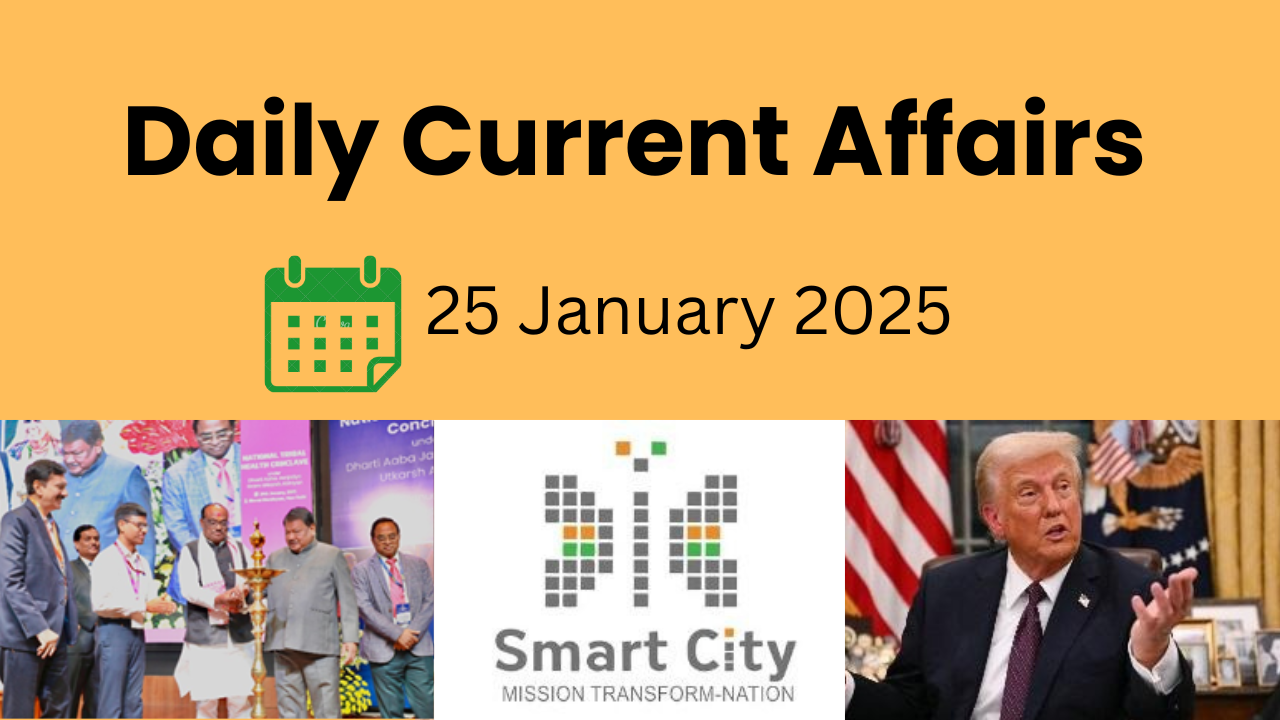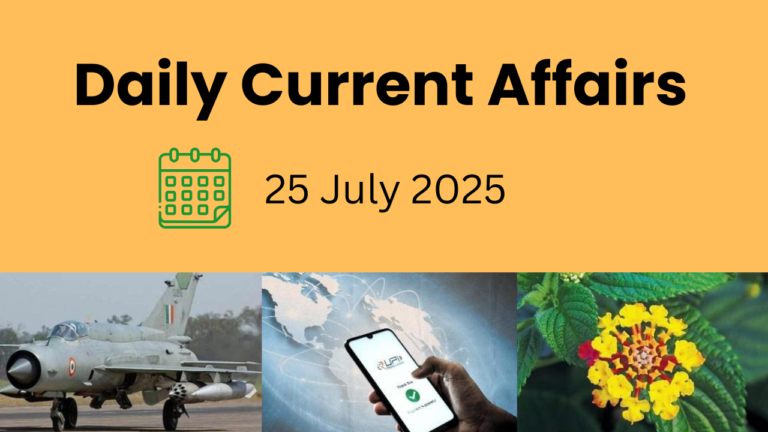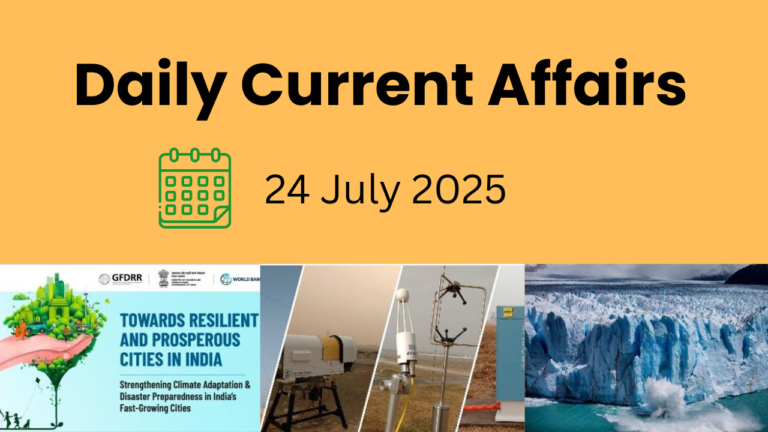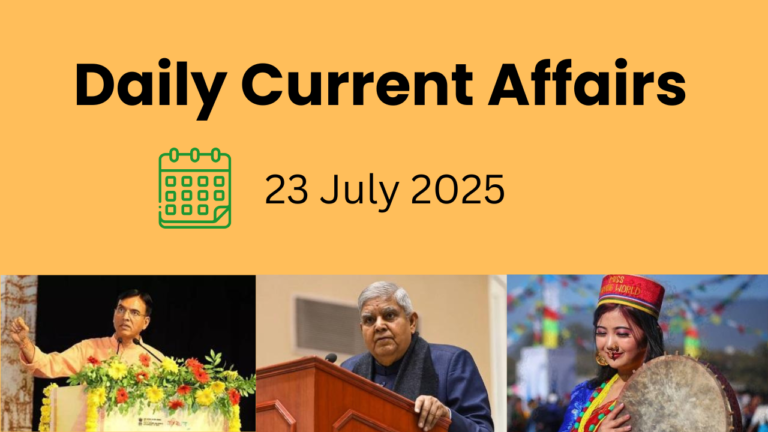1. Status of the Smart Cities Mission
Context: India’s Smart Cities Mission aims to transform urban centers into sustainable, innovative, and economically vibrant hubs, addressing the challenges of rapid urbanization.
Key Features:
- Objective:
- Improve urban living by providing core infrastructure, ensuring a clean environment, and enhancing the quality of life.
- Drive economic growth and promote sustainability through integrated development in social, economic, physical, and institutional spheres.
- Operational Framework:
- Selection Process:
- 100 cities were chosen via a two-stage competition.
- Implementation:
- Managed by Special Purpose Vehicles (SPVs) to ensure focused execution.
- Funding:
- Centrally Sponsored Scheme with ₹48,000 crore allocated over five years.
- ₹100 crore per city annually from the central government, matched by states or Urban Local Bodies (ULBs).
- Additional funding through municipal bonds, public-private partnerships (PPP), and other government programs.
- Timeline:
- Extended to March 31, 2025, for project completion.
- Selection Process:
Status of the Smart Cities Mission:
- Achievements:
- Over 8,000 projects launched with an investment of ₹1.6 lakh crore.
- As of July 2024:
- 7,188 projects (90%) completed.
- 75% project completion in 75 cities.
- 17 cities achieved 100% project completion.
- Highlights:
- Focus areas include urban mobility, smart governance, renewable energy, water supply, and sanitation.
- Integration of technologies such as the Internet of Things (IoT) and GIS-based systems for real-time monitoring.
Need for Smart Cities:
- Urban Growth:
- 31% of India’s population resides in urban areas, contributing 63% of GDP (Census 2011).
- By 2030, urban areas are projected to house 40% of the population, contributing 75% of GDP.
- Sustainable Development:
- Balanced growth requires infrastructure development across physical, institutional, social, and economic domains.
Challenges:
- Implementation Hurdles:
- 10% of projects delayed due to legal disputes, delays in clearances, and resource allocation.
- Technological Barriers:
- Deployment of advanced technologies like IoT is hindered in areas lacking basic infrastructure.
- Funding and Engagement:
- Challenges in securing funding, fostering private sector participation, and ensuring citizen involvement.
- Integration Issues:
- Achieving seamless integration across diverse systems and stakeholders remains a significant challenge.
Conclusion and Way Forward:
The Smart Cities Mission holds transformative potential to propel India toward becoming a $10 trillion economy. Its success hinges on:
- Innovative Funding Mechanisms:
- Mobilizing resources through municipal bonds, PPPs, and international partnerships.
- Private Sector Collaboration:
- Leveraging private expertise and investment for faster project execution.
- Citizen-Centric Policies:
- Ensuring public participation and addressing local needs.
- Technology and Infrastructure:
- Efficient use of advanced technologies to ensure long-term sustainability.
Ultimately, the success of the mission will be measured by its ability to improve urban living standards, create economic opportunities, and drive India’s urban transformation. Bold action and visionary planning will shape the nation’s urban future.
2. Uniform Civil Code (UCC) Rules in Uttarakhand
Context: The Uttarakhand Cabinet has approved rules for implementing the Uniform Civil Code (UCC), marking a significant step toward legal uniformity in personal matters.
Background:
- Historic Legislation:
- In 2024, Uttarakhand became the first Indian state post-independence to adopt a UCC through the Uniform Civil Code of Uttarakhand Act, 2024.
- Key Provisions:
- Marriage and Divorce:
- Bans polygamy, nikah halala, child marriage, and extrajudicial divorces.
- Establishes uniform marriageable ages (21 years for men, 18 years for women).
- Property Rights:
- Grants equal property rights to women, while retaining personal laws on guardianship and Hindu Undivided Families.
- Live-in Relationships:
- Recognizes live-in relationships as quasi-marriages, ensuring the legitimacy of offspring.
- Marriage and Divorce:
What is the Uniform Civil Code (UCC)?
A Uniform Civil Code refers to a unified set of laws that apply to all citizens, irrespective of religion, for personal matters such as marriage, divorce, inheritance, and adoption.
- Objective:
Replace diverse personal laws with a common legal framework for equitable governance and social harmony.
Constitutional Provisions:
- Article 44:
- Part of the Directive Principles of State Policy (DPSP), it urges the state to work toward implementing a UCC across the country.
- Though not enforceable by courts, DPSPs guide governance to ensure justice and equity.
- Other References:
- Article 25 and 26: Guarantee the right to freely practice and manage religious affairs.
- The Sixth Schedule protects the autonomy of tribal communities.
UCC in India:
- Goa as a Precedent:
- Goa follows the Portuguese Civil Code of 1867, ensuring uniformity in laws governing marriage, divorce, and succession across all religions.
- The Goa Daman and Diu Administration Act of 1962 allowed the continuation of this Civil Code after Goa joined India.
Arguments in Favor of UCC:
- Uniformity in Governance: Streamlines legal systems and administrative processes, ensuring fair and efficient justice.
- Women’s Rights: Eliminates discriminatory practices in personal laws, providing an egalitarian framework for gender equality.
- Secularism: Reinforces the secular fabric of the nation by treating citizens equally, regardless of religion.
- Judicial Support: The Supreme Court, in cases like Mohd. Ahmed Khan vs Shah Bano Begum (1985), has called for UCC implementation to promote equality.
- National Integration: Promotes a shared legal platform for all communities, fostering unity and national spirit.
Arguments Against UCC:
- Diversity in Laws: Critics argue that India’s pluralistic society makes “one nation, one law” challenging to implement, given existing variations in codified civil and criminal laws.
- Implementation Issues: Practical difficulties in harmonizing laws across communities with distinct traditions and practices.
- Threat to Tribal Customs: Tribal communities fear their unique marriage and death rituals may be restricted under a uniform code.
- Potential Unrest: The UCC could be perceived as tyranny of the majority, sparking social and political unrest.
- Constitutional Concerns: Opponents view UCC as infringing on religious freedoms guaranteed under Articles 25 and 26.
- Law Commission’s Stand: The Law Commission of India has stated that a UCC is “neither necessary nor desirable” at this stage and emphasized reforming discriminatory practices within existing personal laws.
Way Forward:
- Inclusive Dialogue: Authorities must consult diverse communities, legal experts, and stakeholders to foster inclusivity and transparency.
- Focus on Internal Reform: Address inequalities within communities rather than forcing uniformity between communities, as recommended by the Law Commission.
- Gradual Implementation: Pilot programs in willing states like Uttarakhand can provide a roadmap for scaling UCC nationwide.
- Educational Campaigns: Raise awareness about UCC to dispel misconceptions and ensure public participation.
Conclusion:
The implementation of the Uniform Civil Code in Uttarakhand marks a significant step toward legal uniformity and social reform. However, its national adoption requires careful balancing of constitutional freedoms, cultural diversity, and societal consensus. A collaborative and inclusive approach will be essential to ensure that the UCC fosters equality, justice, and unity in India’s diverse landscape.
3. Accessibility of Antivenoms in India
Context: India, despite being the largest producer and consumer of antivenoms, accounts for nearly 50% of global snakebite deaths, emphasizing the urgent need to address challenges in antivenom accessibility and efficacy.
Snakebite Envenoming:
- WHO Classification:
- Recognized as a high-priority neglected tropical disease by the World Health Organization (WHO).
- Globally, 1.8–2.7 million people are envenomed annually.
- Snakebite Scenario in India:
- Around 58,000 deaths are reported annually from 3-4 million snake bites.
- 90% of snakebites are caused by the “big four”:
- Common krait, Indian cobra, Russell’s viper, and saw-scaled viper.
Antivenom Production and Use:
- Antivenoms:
- Purified antibodies designed to neutralize snake venom toxins.
- Listed as essential medicines by the WHO.
- Production Process:
- Horses are injected with controlled venom doses, prompting their immune systems to produce antibodies.
- Antibodies are collected, purified, and formulated into antivenoms for human use.
Challenges in Accessing Antivenoms:
- Geographical Barriers:
- Rural and remote areas often lack healthcare facilities equipped with antivenoms.
- Limited Venom Coverage:
- Indian antivenoms primarily target the “big four” snakes.
- Other venomous species, such as king cobras and pit vipers, are not covered, leading to ineffective treatment.
- Cultural and Social Factors:
- Superstitions and delayed medical intervention due to traditional practices in rural areas worsen outcomes.
- Economic Constraints:
- High production costs make antivenoms inaccessible to economically disadvantaged populations.
- Infrastructure and Logistics:
- Cold storage requirements remain unmet in rural areas due to power and infrastructure deficits.
- Improper storage reduces the efficacy of antivenoms.
Role of the Irular Community:
- The Irular tribe is renowned for its expertise in snake-catching.
- Their ability to extract venom safely in controlled environments ensures a steady supply of high-quality venom for antivenom production in India.
Way Forward:
- National Action Plan for Snakebite Envenoming (NAP-SE):
- Aims to reduce snakebite deaths and disabilities by 50% by 2030.
- Focuses on prevention, timely treatment, and rehabilitation.
- Innovative Antivenom Development:
- Use of recombinant DNA technology to produce synthetic antivenoms free from animal-derived proteins.
- Ensures greater safety and efficacy.
- Diagnostic Advancements:
- Introduction of portable venom-detection kits and rapid diagnostic tools for precise and timely treatment.
- Awareness Campaigns:
- Educating rural populations to overcome superstitions and seek immediate medical attention after snakebites.
- Improving Infrastructure:
- Ensuring cold storage and proper distribution channels for antivenoms in remote areas.
Conclusion:
Addressing the challenges in antivenom accessibility requires a multi-faceted approach, including technological advancements, enhanced infrastructure, and public awareness. With the NAP-SE and innovative strategies, India has the potential to significantly reduce snakebite-related mortality and morbidity, transforming the lives of millions.
4. Policy Framework for Affordable Bioethanol Fuel in India
Context: India holds a unique opportunity to transition towards carbon neutrality, but a key barrier remains the high cost of bioethanol fuel. According to Honda Motor Co. Ltd, while India can significantly contribute to reducing its carbon footprint, it needs government support to make bioethanol pricing more affordable for widespread adoption.
Key Policy Recommendations for Affordable Bioethanol:
- Government Pricing Mechanism:
- Subsidies & Tax Reductions: The government must introduce policies that reduce taxes on bioethanol, making it more competitive with conventional gasoline. Direct subsidies can help lower the cost burden, ensuring bioethanol is more economical for consumers.
- Price Stabilization Strategies: A stabilization fund could mitigate price volatility, ensuring that ethanol prices remain steady despite market fluctuations.
- Incentivizing Bioethanol Production:
- Farmer Support: Increase incentives for farmers to grow ethanol feedstocks like sugarcane, maize, and wheat. Policies could include higher minimum support prices (MSPs) or direct subsidies to encourage large-scale production.
- Research & Development: The government should fund R&D to enhance the efficiency of ethanol production, focusing on non-food feedstocks to reduce costs and reliance on crops like sugarcane.
- Promoting Higher Ethanol Blends:
- Accelerating E20 Implementation: The rollout of E20 (20% ethanol blend) should be prioritized, with a focus on infrastructure investments such as blending stations and fuel distribution networks to make this blend widely available.
- Flex-fuel Vehicle Adoption: Introduce incentives to encourage manufacturers to produce flex-fuel vehicles capable of running on higher ethanol blends. Tax relief and purchase subsidies could increase the adoption of these vehicles.
- Enhancing Fuel Efficiency in Vehicles:
- Collaborations for Innovation: Vehicle manufacturers should be encouraged to invest in innovative technologies that optimize fuel efficiency, enabling vehicles to run smoothly on higher ethanol blends.
- Consumer Incentives for Green Vehicles: Providing tax benefits for consumers who purchase ethanol-compatible vehicles will stimulate demand for greener alternatives.
- Public Awareness & Education:
- Nationwide Campaigns: To ensure consumer acceptance, the government should launch educational campaigns that highlight the environmental benefits and long-term cost savings of ethanol as an alternative fuel.
- Transparency in Fuel Efficiency: Providing clear information on fuel efficiency for vehicles using ethanol blends will help consumers make informed decisions.
- Developing Infrastructure:
- Building Blending Stations: Invest in the establishment of ethanol production plants and blending units to support increased demand for ethanol-based fuels.
- Improving Distribution Networks: The expansion of supply chains will ensure that bioethanol fuel is readily available in both urban and rural areas.
- Sustainability and Environmental Impact:
- Monitoring Sustainability: Establish an independent body to oversee ethanol production and ensure it is sustainable, balancing environmental and agricultural needs.
- Cleaner Alternative to Gasoline: Position ethanol as a clean-burning fuel that helps reduce greenhouse gas emissions and air pollution, aligning with India’s long-term environmental goals.
- Encouraging Private Sector Participation:
- Fostering Private Investment: Incentives like tax breaks and financial support for private companies willing to invest in ethanol infrastructure and production will drive growth in the sector.
- Public-Private Partnerships (PPP): Strong partnerships between the government and private players can lead to better resource mobilization and implementation of large-scale ethanol projects.
- International Collaboration & Best Practices:
- Exporting Surplus Ethanol: India can explore opportunities to export ethanol to other countries, thus improving the domestic supply chain and boosting the economy.
- Global Partnerships: By engaging with countries successfully running ethanol blending programs, India can adopt global best practices and accelerate its own bioethanol objectives.
- Continuous Monitoring & Program Evaluation:
- Ethanol Program Oversight: Establish a dedicated body to monitor the progress of the Ethanol Blended Petrol (EBP) program, ensuring targets are met and potential challenges are addressed proactively.
Conclusion:
India’s Ethanol Blended Petrol Program is a critical step towards achieving energy security, carbon neutrality, and a self-reliant energy future. By implementing a comprehensive policy that addresses pricing affordability, supply chain expansion, and consumer adoption, India can harness the full potential of bioethanol and reduce its dependency on fossil fuels. This approach will not only benefit the environment but also support the agricultural sector and enhance national security.
5. US Withdrawal from the Paris Agreement: Implications and Global Consequences
Context: In a controversial move, US President Donald Trump once again decided to withdraw the United States from the Paris Agreement, a decision he initially made in 2017. This decision marks a significant shift in the US’s approach to climate action, as it reverts to a policy that prioritizes national energy production over global environmental commitments.
Trump’s Climate Policy: A Reversal of Progress:
On his first day in office, Trump also ordered the revocation of all climate finance commitments made by the US, undoing the progress made under his predecessor, Barack Obama. He emphasized his goal to extract more oil and gas for America’s energy needs, while rolling back several climate-friendly policies enacted in previous years.
Background: Shifting Positions on Global Climate Agreements
While Trump took the US out of the Paris Agreement, his successor, Joe Biden, rejoined the accord in 2021. The US also had a longstanding history of resistance to international climate protocols—the Kyoto Protocol (1997)—which it signed but never ratified.
The Paris Agreement: A Global Climate Commitment:
The Paris Agreement, adopted in 2015 during COP21 under the UN Framework Convention on Climate Change (UNFCCC), is a legally binding treaty designed to combat climate change. Its primary goals are to limit global warming to below 2°C above pre-industrial levels, with an aspirational goal of limiting it to 1.5°C.
- Nationally Determined Contributions (NDCs): Countries must outline and update their climate actions every five years to progressively enhance efforts.
- Withdrawal Procedure: According to Article 28, a country may withdraw after three years from the agreement’s enforcement by providing a written notification.
Trump’s Rationale: Unfair Global Regulations:
Trump’s decision to exit the agreement was largely motivated by his belief that international climate regulations were unfair to the US. He specifically criticized the lack of similar restrictions placed on China, which, as a developing nation, had fewer binding commitments under the agreement.
Implications of the US Withdrawal
- Emission Targets and Climate Goals:
- The US had set ambitious emission reduction targets, aiming for a 50-52% decrease by 2030 (from 2005 levels) and 62-66% by 2035. However, under Trump’s policies, the US is on track to miss these goals, potentially making it almost impossible to meet them within the given timeframe.
- Impact on Global Emissions:
- As the second-largest emitter of greenhouse gases globally, the US’s full participation is essential to the success of the Paris Agreement. Without it, the global effort to reduce carbon emissions faces an uphill battle.
- Fossil Fuel Production Surge:
- Trump’s explicit commitment to increase fossil fuel production—including drilling for oil and gas in previously restricted areas—may lead to a rise in emissions and an overall increase in global warming.
- Climate Finance for Developing Nations:
- The US plays a central role in funding climate action for developing countries. Trump’s policies may undermine the flow of climate finance, putting vulnerable nations at greater risk of environmental disaster.
- Global Impact: A Ripple Effect:
- Experts fear that the US withdrawal could encourage other major emitters, particularly China, to ease off their own climate commitments, undermining global progress on carbon reduction.
The Urgent Need for Climate Action:
As global temperatures rise, the world has already warmed by approximately 2.3°F (1.3°C) since the mid-1800s. The year 2020 recorded the warmest year on record, with temperatures surpassing 2.7°F (1.5°C) above pre-industrial levels.
- The US’s contribution to global warming is substantial—accounting for nearly 22% of global carbon emissions since 1950, making it one of the largest historical polluters. With this immense responsibility, the US must be a key player in combating climate change.
Conclusion: The Path Forward
While Trump’s withdrawal from the Paris Agreement represents a setback, the US can still play a pivotal role in combating climate change. Focusing on the clean energy industry, innovation in energy technologies, and reducing energy costs could drive the US toward a more sustainable and climate-conscious future. The world will be watching to see if the US shifts its stance back to climate leadership in the coming years.
6. National Tribal Health Conclave 2025: Advancing Healthcare for Tribal Communities
Context: The National Tribal Health Conclave 2025 was recently held at Bharat Mandapam, New Delhi, bringing focus to the health and well-being of tribal communities across India.
Tribal Communities: Custodians of Rich Traditions
Who are Tribal Communities?
Tribal communities in India are known for their vibrant traditions, unique lifestyles, and rich cultural heritage. These groups often live in geographical isolation, maintaining a self-contained, homogeneous way of life compared to non-tribal populations.
Tribal Presence in India:
- India is home to one of the largest tribal populations in the world, with nearly 100 million tribal people, often referred to as “Adivasis” (original inhabitants).
- The term “Adivasi” is internationally recognized, with the International Labour Organization (ILO) classifying them as indigenous peoples.
- According to Census 2011, tribes account for 8.9% of India’s population.
Settlement Patterns:
- Northeastern Tribes: Found in states like Nagaland, Mizoram, and Manipur, they live in relative isolation, preserving distinct ethnic identities.
- Central and Southern Tribes: Constituting over 80% of the tribal population, they interact more frequently with non-tribal communities.
Historical Significance of Tribal Communities:
- Tribal groups have played a pivotal role in Indian history since the eras of the Ramayana and Mahabharata.
- Their contribution to the freedom struggle includes iconic movements such as the Khasi-Garo, Mizo, and Kol uprisings.
- Adivasi leaders like Gond Maharani Veer Durgavati, Rani Kamalapati, and the Bhils, who supported Maharana Pratap, exemplify their courage.
- To honor tribal contributions, November 15 is celebrated as Janjatiya Gaurav Divas, marking the birth anniversary of Bhagwan Birsa Munda.
Key Government Initiatives for Tribal Welfare:
Empowering Tribal Development:
- TRIFED (Tribal Cooperative Marketing Development Federation of India Limited): Established in 1987 under the Ministry of Tribal Affairs, TRIFED supports tribal livelihoods.
- Pradhan Mantri Adi Adarsh Gram Yojana (PMAAGY): Focuses on improving infrastructure in villages with a significant tribal population.
- PM JANMAN (Pradhan Mantri Janjati Adivasi Nyaya Maha Abhiyan): Launched in 2023, this initiative targets the socio-economic upliftment of Particularly Vulnerable Tribal Groups (PVTGs).
Improving Tribal Health:
- National Tribal Health Conclave: Jointly organized by the Ministry of Tribal Affairs (MoTA) and the Ministry of Health and Family Welfare (MoH&FW), it aims to enhance health services for tribal populations.
- National Sickle Cell Elimination Mission: Launched by Prime Minister Narendra Modi to eliminate sickle cell anemia by 2047.
- Bhagwan Birsa Munda Chair of Tribal Health and Haematology: Established at AIIMS Delhi for dedicated research on tribal health issues.
Constitutional Safeguards for Tribal Communities:
The Indian Constitution ensures special provisions to protect the rights and promote the welfare of tribal groups:
- Article 275(1): Allocates funds to states for tribal welfare and development programs.
Challenges Faced by Tribal Communities:
Key Issues:
- Economic Disparities: Many tribes face poverty, unemployment, and limited access to education and healthcare.
- Cultural Erosion: Loss of traditional knowledge and challenges in preserving cultural heritage.
- Discrimination and Representation: Tribes often encounter marginalization and lack sufficient representation in decision-making processes.
The Road Ahead: Comprehensive Development for Tribal Communities
A Holistic Approach:
- Respect for Cultural Heritage: Recognizing and preserving the unique identity and traditional practices of tribal groups.
- Inclusive Decision-Making: Involving tribal communities in policy-making related to their lands and resources.
- Enhanced Healthcare Access: Strengthening health infrastructure and delivery systems to address tribal-specific challenges.
- Focused Government Policies: Continued support through targeted programs for education, employment, and healthcare.
By addressing these issues, India can ensure that its tribal communities not only thrive but also contribute significantly to the nation’s progress. As custodians of ancient traditions and wisdom, their development is essential for building a more inclusive and equitable society.




